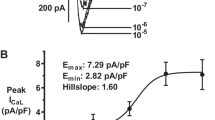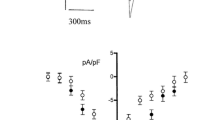Summary
The effects of α1-adrenoceptor stimulation by phenylephrine (PE) and β-adrenoceptor stimulation by isoprenaline (ISO) on Ca2+ current (ICa) and free intracellular Ca2+ concentration ([Ca2+]i) were studied in isolated atrial myocytes from rat hearts. PE did not significantly affect the magnitude of ICa, whereas large increases of peak ICa were observed in response to ISO. In electrically driven cells, PE evoked a concentration-dependent, gradual increase in diastolic [Ca2+]i and, initially, an increase in the height of peak [Ca2+]i transients. When the diastolic [Ca2+]i was increased to a greater extent, the amplitude of [Ca2+]i transients was decreased. Simultaneous measurements of [Ca2+]i and membrane potential showed that the increase in diastolic [Ca2+]i was associated with a depolarization of the membrane, and the greater amplitude of [Ca2+]i transients with a prolongation of the action potential (AP). The PE-induced increase in diastolic [Ca2+]i was eliminated when the cells were voltage-clamped at the original resting membrane potential (RP); under these conditions, an increase in [Ca2+]i transients was observed in response to PE. ISO usually caused larger increases in the amplitude of [Ca2+]i transients with only minor changes in diastolic [Ca2+]i. These results suggest that PE and ISO increase the amplitude of [Ca2+]i transients in rat atrium in different ways. The increase in [Ca2+]i transients in response to β-adrenoceptor stimulation is commonly thought to be mediated by a greater conductance of voltage-dependent Ca2+ channels causing a greater Ca2+ influx and a release of more Ca2+ from the sarcoplasmic reticulum during the AP. The increase in diastolic [Ca2+]i in response to PE is probably a consequence of the depolarization of the membrane, possibly involving the voltage-dependent Na+-Ca2+ exchange mechanism. The increase in the amplitude of the [Ca2+]i transients in response to PE may be ascribed both to the initial increase in diastolic [Ca2+]i and the prolongation of the AP.
Similar content being viewed by others
References
Allen DG, Blinks JR, Prendergast FG (1977) Aequorin luminescence: relation of light emission to calcium concentration —A calcium-independent component. Science 196:996–998
Apkon M, Nerbonne JM (1988) α1-Adrenergic agonists selectively suppress voltage-dependent K+ currents in rat ventricular myocytes. Proc Natl Acad Sci USA 85:8756–8760
Arnold A (1980) Sympathomimetic amine-induced responses of effector organs subserved by alpha-, beta1-, and beta2-adrenoceptors. In: Szekeres L (ed) Handbook of experimental pharmacology, vol 54/1. Springer, Berlin Heidelberg New York, pp 63–88
Brückner R, Scholz H (1984) Effects of α-adrenoceptor stimulation with phenylephrine in the presence of propranolol on force of contraction, slow inward current and cyclic AMP content in the bovine heart. Br J Pharmacol 82:223–232
Brückner R, Mügge A, Scholz H (1985) Existence and functional role of alpha1-adrenoceptors in the mammalian heart. J Mol Cell Cardiol 17:639–645
Capogrossi MC, Kachadorian WA, Gambassi G, Spurgeon HA, Lakatta EG (1991) Ca2+ dependence of α-adrenergic effects on the contractile properties and Ca2+ homeostasis of cardiac myocytes. Circ Res 69:540–550
Crespo LM, Grantham CJ, Cannell MB (1990) Kinetics, stoichiometry and role of the Na-Ca exchange mechanism in isolated cardiac myocytes. Nature 345:618–621
Drummond AH, Severson DL (1979) Cyclic nucleotides and cardiac function. Circ Res 44:145–153
Endoh M (1982) Adrenoceptors and the myocardial inotropic response: Do alpha and beta receptor sites functionally coexist? In: Kalsner S (ed) Trends in autonomic pharmacology: Urban & Schwarzenberg, Baltimore, pp 303–322
Endoh M, Blinks JR (1988) Actions of sympathomimetic amines on the Ca2+ transient and contractions of rabbit myocardium: reciprocal changes in myofibrillar responsiveness to Ca2+ mediated through α- and β-adrenoceptors. Circ Res 62:247–265
Ertl R, Jahnel U, Nawrath H, Carmeliet E, Vereecke J (1991) Differential electrophysiologic and inotropic effects of phenylephrine in atrial and ventricular heart muscle preparations from rats. Naunyn-Schmiedeberg's Arch Pharmacol 344:574–581
Fabiato A, Fabiato F (1977) Calcium release from the sarcoplasmic reticulum. Circ Res 40:119–129
Fedida D, Shimoni Y, Giles WR (1990) α-Adrenergic modulation of the transient outward current in rabbit atrial myocytes. J Physiol (Lond) 423:257–277
Grynkiewics G, Poenie M, Tsien RY (1985) A new generation of Ca2+ indicators with greatly improved fluorescence properties. J Biol Chem 260:3440–3450
Hamill OP, Marty A, Neher E, Sakmann B, Sigworth FJ (1981) Improved patch-clamp techniques for high resolution current recording from cells and cell-free membrane patches. Pflügers Arch 391:85–100
Hartmann HA, Mazzocca NJ, Kleiman RB, Houser SR (1988) Effects of phenylephrine on calcium current and contractility of feline ventricular myocytes. Am J Physiol 255:H1173-H1180
Hescheler J, Nawrath H, Tang M, Trautwein W (1988) Adrenoceptor-mediated changes of excitation and contraction in ventricular heart muscle from guinea pigs and rabbits. J Physiol (Lond) 397:657–670
Jahnel U, Nawrath H, Carmeliet E, Vereecke J (1991) Depolarization-induced influx of sodium in response to phenylephrine in rat atrial heart muscle. J Physiol (Lond) 432:621–637
Kohl C, Schmitz W, Scholz H, Scholz J (1990) Evidence for the existence of inositol tetrakisphosphate in mammalian heart. Circ Res 66:580–583
Movsesian MA, Thomas AP, Selak M, Williamson JR (1985) Inositol trisphosphate does not release Ca2+ from permeabilized cardiac myocytes and sarcoplasmic reticulum FEBS Lett J. 185:328–332
Mullins LJ (1979) The generation of electric currents in cardiac fibers by Na/Ca exchange. Am J Physiol 236:C103-C110
Näbauer M, Callewaert G, Cleemann L, Morad M (1989) Regulation of calcium release is gated by calcium current, not gating charge, in cardiac myocytes. Science 244:800–803
Nawrath H (1989) Adrenoceptor-mediated changes of excitation and contraction in isolated heart muscle preparations. J Cardiovasc Pharmacol 14 [Suppl 111]:S1-S10
Nosek TM, Williams MF, Zeigler ST, Godt RE (1986) Inositol trisphosphate enhances calcium release in skinned cardiac and skeletal muscle. Am J Physiol 250: C807-C811
Okumura K, Kawai T, Hashimoto H, Ito T, Ogawa K, Satake T (1988) Sustained diacylglycerol formation in norepinephrine-stimulated rat heart is associated with α1-adrenergic receptor. J Cardiovasc Pharmacol 11:651–656
Poggioli J, Sulpice JC, Vassort G (1986) Inositol phosphate production following α1-adrenergic, muscarinic or electrical stimulation in isolated rat heart. FEBS Lett 206:292–298
Puceat M, Clement O, Lechene P, Pelosin JM, Ventura-Clapier R, Vassort G (1990) Neurohormonal control of calcium sensitivity of myofilaments in rat single heart cells. Circ Res 67:517–524
Rana RS, Hokin LE (1990) Role of phosphoinositides in transmembrane signaling. Physiol Rev 70:115–164
Ravens U, Wang X-L, Wettwer E (1989) Alpha adrenoceptor stimulation reduces outward currents in rat ventricular myocytes. J Pharmacol Exp Ther 250:364–370
Reeves JP (1990) Sodium-calcium exchange. In: Bronner F (ed) Intracellular calcium regulation. Alan Liss, New York, pp 305–347
Reuter H (1974) Localization of beta adrenergic receptors, and effects of noradrenaline and cyclic nucleotides on action potentials, ionic currents and tension in mammalian cardiac muscle. J Physiol (Lond) 242:429–451
Shah A, Cohen IS, Rosen MR (1988) Stimulation of cardiac alpha receptors increases Na/K pump current and decreases gK via a pertussis toxin-sensitive pathway. Biophys J54:219–225
Tohse N, Nakaya H, Hattori Y, Endou N, Kanno M (1990) Inhibitory effect mediated by α1-adrenoceptors on transient outward current in isolated rat ventricular cells. Pflügers Arch 415: 575–581
Wagner J, Brodde O-E (1978) On the presence and distribution of α-adrenoceptors in the heart of various mammalian species. Naunyn-Schmiedeberg's Arch Pharmacol 302:239–254
Author information
Authors and Affiliations
Additional information
Send offprint requests to H. Nawrath at the above address
Rights and permissions
About this article
Cite this article
Jahnel, U., Nawrath, H., Shieh, RC. et al. Modulation of cytosolic free calcium concentration by α1-adrenoceptors in rat atrial cells. Naunyn-Schmiedeberg's Arch Pharmacol 346, 88–93 (1992). https://doi.org/10.1007/BF00167576
Received:
Accepted:
Issue Date:
DOI: https://doi.org/10.1007/BF00167576




